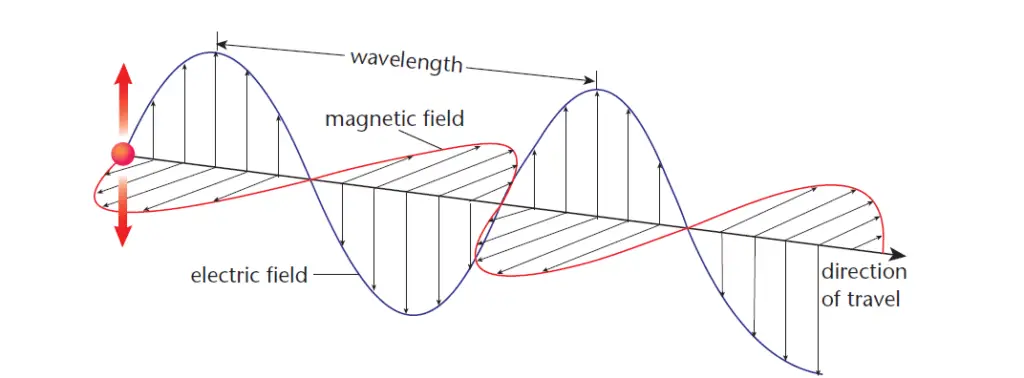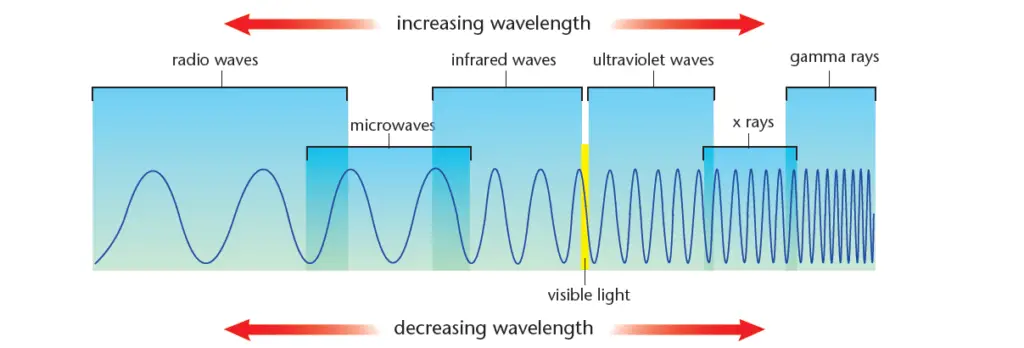Nature of electromagnetic radiation & The Electromagnetic Spectrum
In this post, we will discuss the nature of electromagnetic radiation (transverse wave type, electric field, magnetic field, frequency, wavelength, propagation, intensity, etc.). And, we will also cover the Electromagnetic Spectrum.
Light waves and all electromagnetic waves are transverse waves. A wave on a rope is a transverse wave that causes the rope to move at right angles to the direction the wave is traveling.
Electromagnetic waves are transverse waves – An electromagnetic wave traveling through matter can also cause matter to move at right angles to the direction the wave is moving. An electromagnetic wave contains an electric part and a magnetic part, as shown in Figure 1. Both parts are called fields and vibrate at right angles to the wave motion.
Frequency and wavelength of an electromagnetic wave – The number of times the electric field and magnetic fields of an electromagnetic wave vibrate each second is the frequency of the wave. The wavelength is the distance between two consecutive crests or troughs of the vibrating electric or magnetic parts.

How does an electromagnetic wave propagate?
The electromagnetic wave propagates in the following way. The electric field oscillates in one plane and induces a magnetic field that oscillates in a plane at a right angle to it. The oscillating magnetic field produces an oscillating electric field again, and so on. So the electric field and magnetic field oscillate in phase and at right angles to each other. Both fields are perpendicular to the direction of propagation.
Intensity of light waves
The intensity of waves is a measure of the amount of energy that the waves carry. For light waves, the intensity determines the brightness of the light. A dim light has lower intensity because the waves carry less energy. However, as you move away from a light source, the energy spreads out and the intensity decreases.
The Electromagnetic Spectrum
Electromagnetic radiation is an oscillation of electrical and magnetic fields that travels through space as a wave and carries energy. The electromagnetic spectrum is the range of all possible frequencies of electromagnetic radiation. The electromagnetic spectrum is split into several regions, according to its wavelength (or frequency). Different regions of the spectrum require different detectors and have different applications.
There is an entire spectrum of electromagnetic waves, as shown in Figure 2.
An entire spectrum of electromagnetic waves consists of Radio waves, Microwaves, Infrared, Visible Light, Ultraviolet, X-rays, and Gamma rays.
The electromagnetic spectrum is the complete range of electromagnetic wave frequencies and wavelengths. At one end of the spectrum, the waves have low frequencies, long wavelengths, and low energy. At the other end of the spectrum, the waves have high frequencies, short wavelengths, and high energy. All waves — from radio waves to visible light to gamma rays – are the same kind of waves. They differ from each other only by their frequencies, wavelengths, and energy.

Certain kinds of electromagnetic radiation such as ultra-violet radiation, X-rays, and gamma rays are very dangerous. Radiation such as these is called ionizing radiation. Ionizing radiation transfers energy as it passes through matter, breaking molecular bonds and creating ions. Excessive exposure to radiation, including sunlight, X-rays, and all nuclear radiation, can cause the destruction of biological tissue. Luckily, the Earth’s atmosphere protects us and other living beings on Earth from most of the harmful electromagnetic (EM) radiation. [ Applications of different electromagnetic waves of the electromagnetic spectrum ]
Wavelength and frequency ranges of the electromagnetic spectrum
An entire spectrum of electromagnetic waves consists of Radio waves, Microwaves, Infrared, Visible Light, Ultraviolet, X-rays, and Gamma rays. Table 1 lists the wavelength and frequency ranges of the electromagnetic spectrum.

Read More:
Applications of different electromagnetic waves of the electromagnetic spectrum
